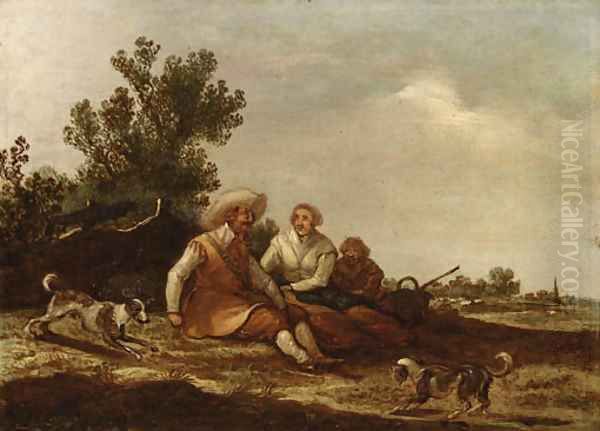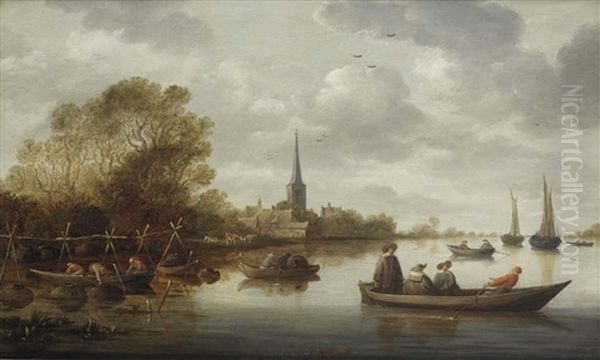
Pieter de Neyn (1597-1639) stands as a notable figure among the landscape painters of the Dutch Golden Age. Though his life was relatively short, his work contributes significantly to our understanding of the Dutch countryside and the artistic currents of the early seventeenth century. He specialized in depicting the familiar scenes of his native Holland, capturing the essence of rural life with a distinctive naturalism.
Early Life and Artistic Formation
Born in the university city of Leiden in 1597, Pieter de Neyn's path to becoming a painter was not immediate. His initial training was far removed from the artist's studio; he first apprenticed as a stonemason. This early exposure to a craft demanding precision and an understanding of form may have subtly informed his later artistic endeavors. Following this period, De Neyn transitioned into the role of a teacher, further broadening his intellectual horizons by pursuing studies in mathematics and architecture. This diverse background suggests an individual with a keen mind and varied interests before fully dedicating himself to painting.
Despite spending the majority of his life in his hometown of Leiden, De Neyn sought formal artistic training in The Hague, a major center for art production and patronage at the time. This move was crucial for his development, placing him under the tutelage of two highly significant masters of Dutch landscape painting: Esaias van de Velde and Jan van Goyen. Both artists were pioneers in the move towards a more naturalistic and atmospheric depiction of the Dutch landscape, breaking away from the more stylized conventions of earlier periods.

Esaias van de Velde, known for his lively and often colorful scenes featuring elegant figures in landscapes, provided De Neyn with a foundation in contemporary landscape trends. Jan van Goyen, however, appears to have exerted a particularly profound and lasting influence on De Neyn's artistic style. Van Goyen became a leading exponent of the "tonal phase" of Dutch landscape painting, characterized by a limited, often monochromatic palette and a focus on capturing atmospheric effects. His impact is clearly visible in De Neyn's subsequent work. Studying in The Hague placed De Neyn within a vibrant artistic milieu, contemporary with other landscape innovators like Hercules Segers, known for his experimental techniques, and early specialists in winter scenes such as Hendrick Avercamp.
Artistic Style and Themes
Pieter de Neyn's paintings are celebrated for their naturalism and their truthful representation of everyday scenes in the Dutch countryside. He eschewed idealized or mythological landscapes in favor of the familiar world around him. His works often feature the tranquil, sometimes rugged, terrain characteristic of Holland, populated by the ordinary people who inhabited it.
Common subjects in his oeuvre include rustic farmhouses, often depicted as somewhat dilapidated, suggesting the realities of rural existence rather than a romanticized view. Weathered,摇摇欲坠的木栅栏 (rickety wooden fences) are another recurring motif, adding to the sense of authenticity. Travelers on foot or horseback navigating country paths are frequently featured, providing narrative interest and scale within the landscape. These figures, sometimes simple peasants, sometimes more well-attired individuals, animate his scenes and reflect the movement and life of the countryside.
De Neyn's compositional approach is generally clear and well-structured. Snippet 4 specifically notes his use of horizontal bands of color and stripes of shadow, techniques often employed by landscape painters of the period, including his teacher Jan van Goyen, to create depth and structure the view. This method helps to lead the viewer's eye through the scene and emphasizes the flatness or rolling nature of the Dutch terrain.
The influence of Jan van Goyen is particularly evident in De Neyn's color palette. While described generally as vivid and layered, his works often employ the subdued, tonal harmonies associated with Van Goyen and other Haarlem school painters like Salomon van Ruysdael and Pieter de Molijn. Specific mention is made of his use of yellows, browns, and light greens, especially effective in rendering the sandy soil and sparse vegetation of dune landscapes, a recurring setting in his work. Towering trees, another typical element of Dutch landscape painting, also feature in his compositions, providing vertical accents and framing devices.
Representative Works

Among Pieter de Neyn's known works, certain paintings stand out as exemplary of his style and thematic concerns. Travellers in a Dune Landscape (also referred to as Travellers Progressing in a Dune Landscape) is frequently cited. This painting depicts two well-dressed travelers on horseback making their way along a country path. The setting is characteristic, featuring the yellow hues of the dunes under a wide sky. In the background, the presence of a high church spire anchors the scene and provides a sense of place, likely referencing a specific location recognizable to contemporary viewers. This work showcases his ability to combine landscape depiction with narrative elements and attention to detail in the figures' attire.
Another significant work mentioned is Peasant Cottage and Travellers (or Peasant Cottage and Horseman along a Sandy Road). While the description is less detailed, the title itself points to De Neyn's core subject matter: the humble architecture of the countryside juxtaposed with the transient presence of travelers. Such scenes allowed him to explore the textures of building materials, the quality of light on sandy roads, and the simple interactions or journeys of rural inhabitants. These paintings effectively capture the unpretentious beauty and quietude of the Dutch landscape and the lives lived within it. They reflect his deep understanding and appreciation for the specific character of his native land.
Career and Context
Pieter de Neyn's professional life unfolded primarily in Leiden, his place of birth and residence for most of his years, even after his formative training period in The Hague. During his lifetime, his talents were recognized, and his works found favor among contemporary art enthusiasts and merchants. The Dutch Republic in the seventeenth century witnessed an unprecedented boom in art production and collecting, particularly in genres like landscape, still life, and scenes of daily life, which appealed to the tastes of the prosperous merchant class. De Neyn's focus on recognizable Dutch scenes fit well within this market.
Despite this contemporary appreciation, detailed records of his life remain scarce. Art historical knowledge about many artists from this period relies on guild records, notary documents, and occasional mentions in letters or inventories, and for De Neyn, such sources have yielded limited biographical insights. We know of his teachers and the general trajectory of his career, but specifics about patrons, commissions, or personal life are not extensively documented in the provided texts.
His life was cut short in 1639, when he was only about 42 years old. Some literature suggests that his early death may have been due to lung disease, a plausible ailment given the conditions of the time, though this remains speculative based on the available information. His relatively brief career means his oeuvre is not as extensive as that of some contemporaries who lived longer, like Jacob van Ruisdael or Aelbert Cuyp, who further developed Dutch landscape painting in the following decades, sometimes building on the foundations laid by artists like De Neyn and his teachers. The lack of detailed records also extends to his interactions with other artists; the provided texts explicitly state there is no direct mention of collaborations or specific documented exchanges with painters beyond his teachers, although he worked within a milieu that included figures like Cornelis Vroom and the aforementioned Pieter de Molijn and Salomon van Ruysdael.
Legacy and Rediscovery
Pieter de Neyn's artistic legacy is primarily defined by his sensitive and naturalistic portrayals of the Dutch rural landscape. He absorbed the crucial lessons of his teachers, Esaias van de Velde and particularly Jan van Goyen, translating their innovations into his own distinct vision. His work exemplifies the broader shift in Dutch art towards realism and the celebration of the local environment during the Golden Age.
While appreciated in his own time, like many artists of the period, his reputation may have faded somewhat in the centuries immediately following his death. However, the provided information notes that his work was rediscovered in the nineteenth century. This period saw a renewed scholarly and collector interest in Dutch Golden Age painting, leading to the re-evaluation of many previously overlooked masters. This rediscovery acknowledged his contribution to the development of landscape painting.
The texts mention that his work influenced later artists, although specific names are not provided in the source material. His depictions of dune landscapes, his handling of light and shadow, and his focus on the textures and atmosphere of the Dutch countryside likely resonated with subsequent generations of landscape painters, contributing to the rich and enduring tradition of landscape art in the Netherlands, which continued with artists such as Meindert Hobbema. Pieter de Neyn remains an important figure for his dedicated portrayal of his homeland, capturing the quiet dignity of its landscapes and the simplicity of its rural life during a vibrant period of artistic creation.